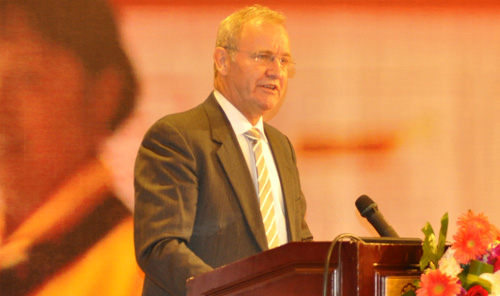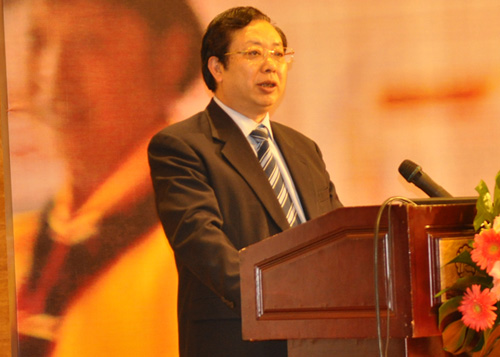Aging country presents challenges, opportunities
- By Pang Li
 0 Comment(s)
0 Comment(s) Print
Print E-mail China.org.cn, October 23, 2012
E-mail China.org.cn, October 23, 2012
 |
|
Arie Hoekman, UNFPA representative in China, delivers a speech at a seminar on aging in Beijing on Monday. [Pang Li/China.org.cn] |
As China faces the challenge of taking care of its aging population, new opportunities for business and society will emerge, experts said at a seminar in Beijing on Monday.
By the end of 2011, China had 185 million people aged 60 and above, accounting for 13.7 percent of its population. By 2053, its elderly population will peak at around 487 million, or 34 percent of the total population. Now, Chinese seniors make up 22 percent of the world's elderly and by 2050, they will account for 26 percent.
"China as the most populous county in the world will see its number and proportion of elderly increase at an accelerating pace over the coming decades, much faster than the pace experienced by many of the already more advanced aging countries. As a consequence, China will have less time to put in place all the complex policies and strategies meant to respond properly to challenges and opportunities posed by an aging society, and time is actually already not on our side," said Arie Hoekman, representative of the United Nations Population Fund (UNFPA) in China, at the seminar.
"China is facing greater challenges from its aging society than developed countries, as its pace of aging outgrows its economic development. [China] faces the challenges of raising the senior people's living standards and sustaining economic growth," said Chen Chuanshu, standing vice president of the China National Committee on Aging (CNCA).
|
|
|
Chen Chuanshu, standing vice president of the China National Committee on Aging (CNCA), delivers a speech at a seminar on aging in Beijing on Monday. [Pang Li/China.org.cn] |
Statistics from the national census show that older people accounted for around 15 percent of the rural population in 2010, much higher than the urban percentage of 12 percent. At least 62 million seniors, or 32 percent of the elderly population, live in so-called "empty nest" households with their children living away from them.
Du Peng, a professor at Renmin University of China, said that one-third of China's 401 million households had one or two people aged 60 and above in 2010. At the same time, migration to towns and cities has greatly impacted the demographic structure of rural areas.
Although China's aging presents a big challenge for the government, a plenty of opportunities will emerge for both business and society, Hoekman said. "[Business] opportunities are as endless as the contributions that a socially and economically active, secure and healthy aging population can bring to society. Harnessing these contributions will be very important."
In addition, older people in China are much better educated than before and are thus able to make greater contributions to the country, Du said.
Zhu Yong, vice president of CNCA, said that as the number of elderly people increases, a growing labor shortage will encourage young people to raise productivity, boost scientific advancement and reform the mode of China's economic development. Meanwhile, the elderly serve as valuable boosters to domestic consumption as well as the insurance and service sectors, Zhu said.







Go to Forum >>0 Comment(s)